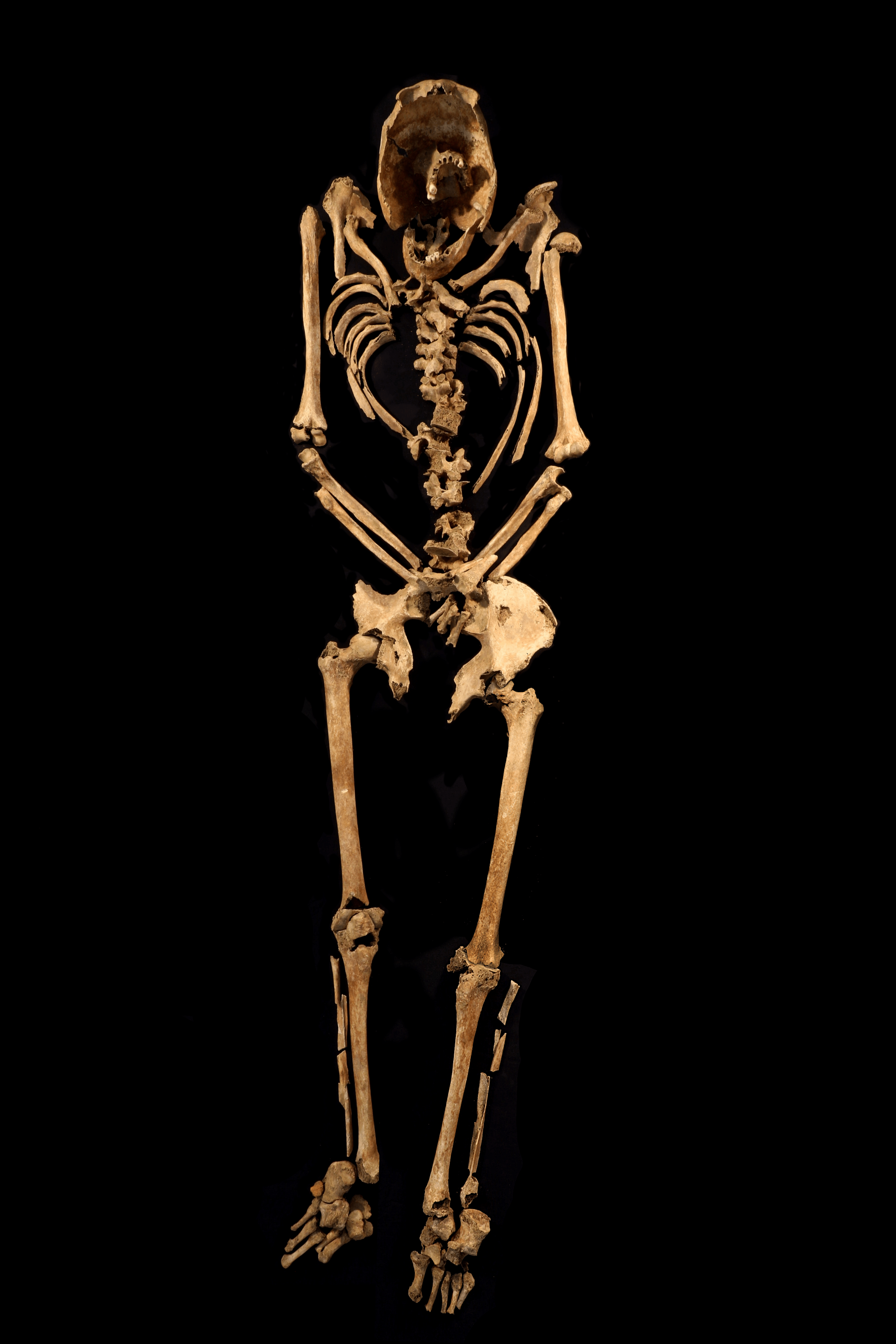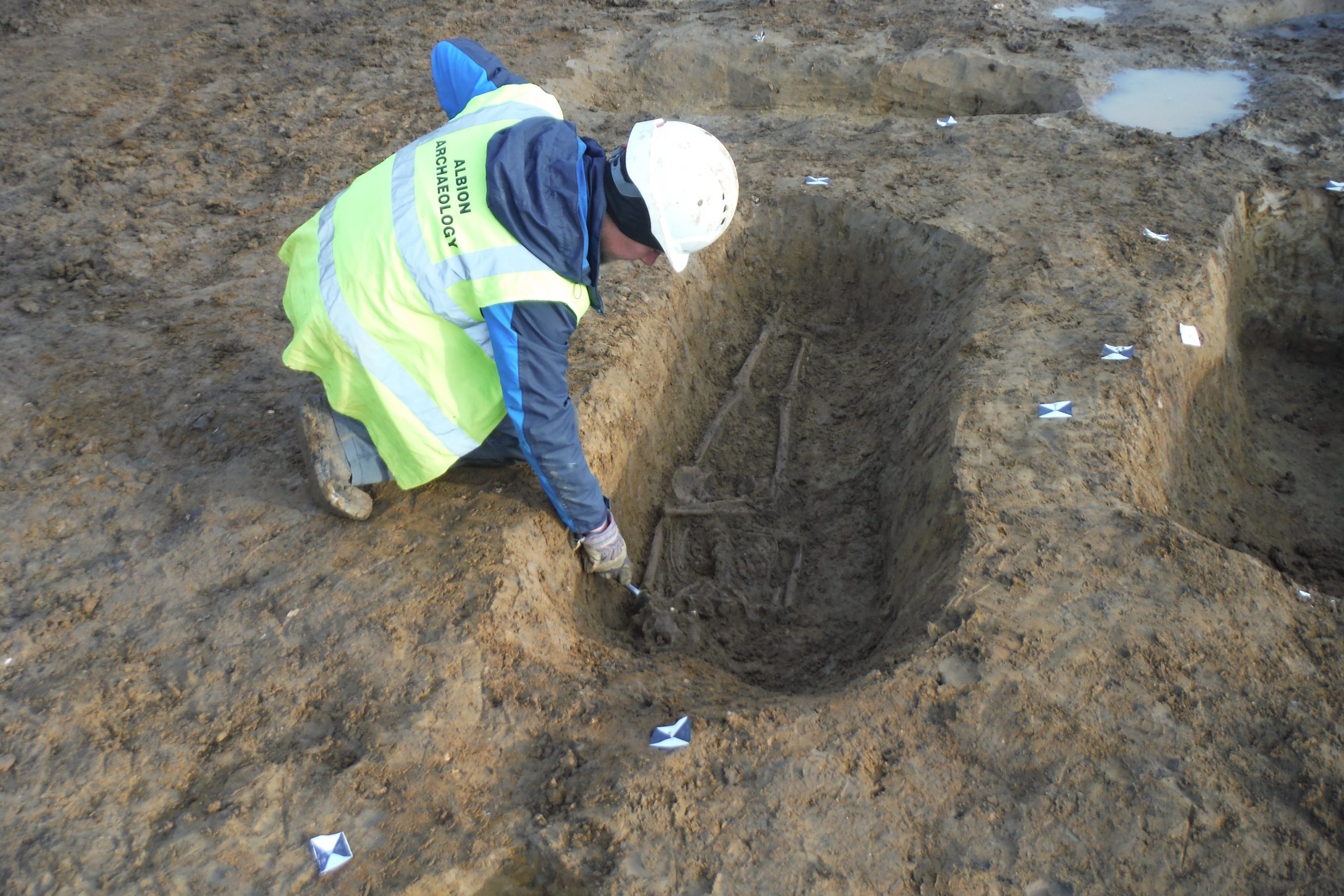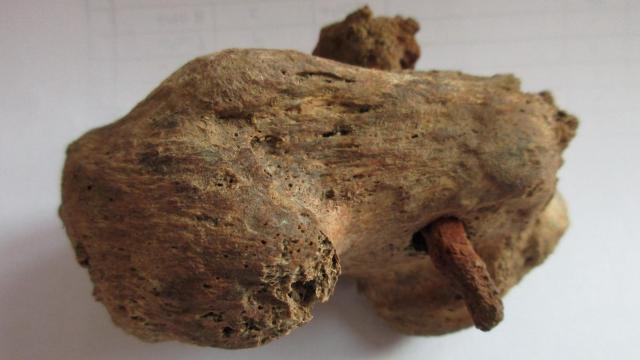Archaeologists in the United Kingdom have unearthed a skeleton with a nail protruding from its right heel bone. The remains likely belonged to a man who was crucified by the Romans, in what is an exceptionally rare discovery.
The archaeological site, located between Cambridge and Huntingdon, was discovered in advance of housing development in the village of Fenstanton, England. David Ingham from Albion Archaeology led the excavation, while osteologist Corinne Duhig from Wolfson College analysed the human bones found at the site.
Ingham and his team performed excavations at the previously unknown Roman-era roadside settlement in 2017 (the delay in publication was on account of the covid-19 pandemic). The remains of 40 adults and five children were found buried across five distinct cemeteries that date back to the third or fourth century CE.
Archaeological artifacts found at the site include enameled brooches, a bone comb, lots of coins, pottery, and troves of butchered animal bones. The amount of wealth found at the site, along with evidence of trade, suggests Fenstanton was a well-organised Roman-era settlement, likely a stopping place for travellers.
Among the buried skeletons was an individual who appears to have been crucified, the evidence being a large iron nail lodged in his right heel bone. The scientists say it’s the first evidence of Roman crucifixion ever to be found in the United Kingdom and also the first in northern Europe. Details of this remarkable discovery were published earlier this week in British Archaeology Magazine (the scientists say further details will be shared in a forthcoming publication).

“The lucky combination of good preservation and the nail being left in the bone has allowed me to examine this almost unique example when so many thousands have been lost,” Duhig explained in an emailed statement. “This shows that the inhabitants of even this small settlement at the edge of empire could not avoid Rome’s most barbaric punishment.”
Indeed, while accounts of Roman crucifixions are abundant, physical evidence of the cruel practice is exceptionally rare. Writing to me in an email, Ingham said the discovery is significant in that, “although there are numerous historical references and pictorial representations of crucifixion, this is only the second time that we’ve found convincing physical evidence of how someone was crucified.”
Seems hard to believe, but such is the case. The other example Ingham is referring to was discovered in 1968 at the Giv‘at ha-Mivtar site in Jerusalem, Israel, in which “a right calcaneum [heel bone] retained a nail which was in exactly the same position as in our case,” the scientists write. Two other possible examples of crucifixion, one from Italy and the other from Egypt, are less convincing as no nails were recovered — only holes left in bones.
Nails weren’t always used during Roman crucifixions. Oftentimes a victim was strapped to a t-shaped frame, known as a patibulum, with their legs braced and tied to either side of an upright post. Crucifixion was a slow form of torture and execution that was eventually abolished by Constantine I in the 4th Century CE. Iron nails, if they were used, were often taken out of the victim’s body for reuse. In this case, however, the nail had to be kept in place, as it was bent and fixed in the bone, according to the research.

Analysis of the skeleton showed that the man suffered before death. Evidence of “new bone on the tibial and fibular shafts suggests infection or inflammation caused by a systemic disorder or by local irritation such as binding or shackles,” the scientists write, adding that this all combines to “create a complex picture of illness or injury, of someone immobilised by trauma, disease or possibly punishment.” Analysis of DNA taken from the bone confirmed the skeleton as belonging to a male, while the level of wear-and-tear on the molars suggests the man died between the age of 25 and 35.
Ingham said the timing of the crucifixion — around the 3rd or 4th century — is significant, as it happened “at a time when the use of crucifixion was generally becoming less widespread,” as he explained in his email. It suggests this person “may have been involved with a crime that the state considered to be particularly serious — perhaps helping to organise sedition among the local population,” he wrote, though exactly what the man was crucified for can only be guessed. He might have “been a slave who was guilty of no more than having a master who had committed such a crime,” Ingham added.

Analysis of the other bodily remains found at the site paint a picture of poor health and suffering. Many skeletons showed signs of extensive dental disease, malaria, and evidence of physical trauma. Fractures were observed on many bodies, including an older woman who had broken both legs at the same time, “and the stresses on her subsequent walking were shown by the severe arthritis in her feet,” write the scientists. The kinds of fractures seen on multiple skeletons “tend to be produced by high-energy events — nowadays contact sports are common causes,” according to the report, and the scientists “can only speculate” as to what happened.
Wow, did people ever have it rough back then. Modern civilisation is far from perfect, but it certainly can’t compare to the way things used to be.
More: Rare Roman Statues Found Beneath Medieval Church in England.
